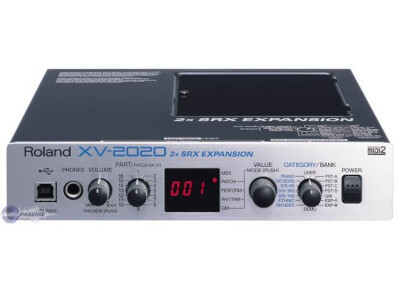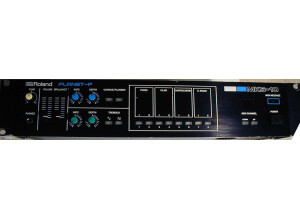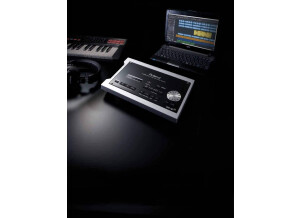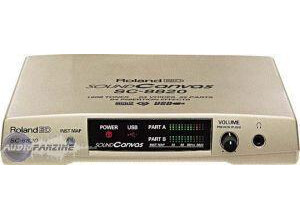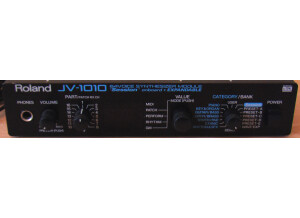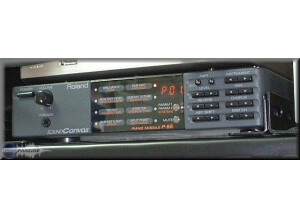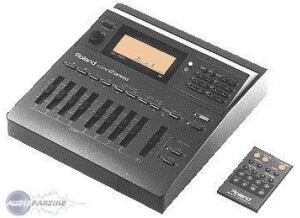Tech. sheet
- Manufacturer: Roland
- Model: XV-2020
- Category: Sound Modules
- Other names:xv 2020, xv2020, xv 20 20, xv20 20
We have no technical specifications for this product
but your help will be much welcomed
»
User reviews
3.5/5(4 reviews)
5
25 %
4
50 %
3
2
1
25 %
cool
Published on 04/05/14 at 00:03 (This content has been automatically translated from French)XV-2020: Module 64-voice polyphonic
(Conforms to General MIDI 2 System)
Parties: 16
Maximum Polyphony: 64 voices
Waveform memory: 64 MB (equivalent to 16-bit linear)
Waveforms: 1083
Extensions: Expansion cards sounds SRX Series: 2 slots
Memory presets:
Patches: 512 (128 x 4 banks) + 256 (Patches General MIDI 2)
Drum Kits (Rhythm Sets): 8 (4 x 2 banks) + 9 (General MIDI drum kit 2)
Performance: 64 (32 x 2 banks)
User memory
Patches: 128
Drum Kits (Rhythm Sets): 4
Performances: 64
Effects
Multi-Effects: 40
Chorus: 1
Reverb: 1 (8 types)
Display
7 segments, 3 characters (LED)
Taken
Headset Jack: Jack stereo 1/4 "
USB connector
Outputs (L...…
(Conforms to General MIDI 2 System)
Parties: 16
Maximum Polyphony: 64 voices
Waveform memory: 64 MB (equivalent to 16-bit linear)
Waveforms: 1083
Extensions: Expansion cards sounds SRX Series: 2 slots
Memory presets:
Patches: 512 (128 x 4 banks) + 256 (Patches General MIDI 2)
Drum Kits (Rhythm Sets): 8 (4 x 2 banks) + 9 (General MIDI drum kit 2)
Performance: 64 (32 x 2 banks)
User memory
Patches: 128
Drum Kits (Rhythm Sets): 4
Performances: 64
Effects
Multi-Effects: 40
Chorus: 1
Reverb: 1 (8 types)
Display
7 segments, 3 characters (LED)
Taken
Headset Jack: Jack stereo 1/4 "
USB connector
Outputs (L...…
Read more
XV-2020: Module 64-voice polyphonic
(Conforms to General MIDI 2 System)
Parties: 16
Maximum Polyphony: 64 voices
Waveform memory: 64 MB (equivalent to 16-bit linear)
Waveforms: 1083
Extensions: Expansion cards sounds SRX Series: 2 slots
Memory presets:
Patches: 512 (128 x 4 banks) + 256 (Patches General MIDI 2)
Drum Kits (Rhythm Sets): 8 (4 x 2 banks) + 9 (General MIDI drum kit 2)
Performance: 64 (32 x 2 banks)
User memory
Patches: 128
Drum Kits (Rhythm Sets): 4
Performances: 64
Effects
Multi-Effects: 40
Chorus: 1
Reverb: 1 (8 types)
Display
7 segments, 3 characters (LED)
Taken
Headset Jack: Jack stereo 1/4 "
USB connector
Outputs (L (MONO), R) (stereo 1/4 ")
Outputs (L, R) (RCA / Cinch)
MIDI connectors (IN, OUT, THRU)
DC IN jack
Terminal grounded
Supply
DC 9 V (adapter)
Consumption
600 mA
Dimensions
218 (L) x 237 (D) x 45 (H) mm
8-5/8 (W) x 9-3/8 (D) x 1-13/16 (H) inches
Weight
1.4 kg / 3 lbs 2 oz (without adapter)
Accessories
Instructions
AC adapter (ACI-120C/ACI-230C/PSB-1U)
CD-ROM (XV Editor, USB driver)
Rubber feet
Options
Expansion card waveforms: SRX Series
Rack adapter RAD-50
UTILIZATION
Super easy to use, the manual is very clear.
The screen is a bit small, but it shows only the numbers corresponding to the sounds used.
Editing sounds is super hard on the device, but it can be done through a supplied software and a USB connection. For a geek I think the software is not bad and is quite full, on the other hand for a beginner like me it is complicated and it is FEAR.
SOUNDS
The sounds are pretty cool, the quality is there.
I love these sounds!
OVERALL OPINION
I used it for 3 months with a keyboard M-Audio Keystation.
I had never used before expander. An expander for me it did not work alone with a master keyboard.
So I can not compare with other expanders.
The cool side with respect to a synthesizer or piano while a is that I can change the keyboard.
The cool side compared to my PREVIOUS solution (PC + software + computer music master keyboard) is that it is lighter to carry, more reliable and easier to access.
It gave me, so I can not really judge the quality / price ratio, but I could spend € 150/200. At the same time I am not a number: I do not know what is being done now and at what price.
(Conforms to General MIDI 2 System)
Parties: 16
Maximum Polyphony: 64 voices
Waveform memory: 64 MB (equivalent to 16-bit linear)
Waveforms: 1083
Extensions: Expansion cards sounds SRX Series: 2 slots
Memory presets:
Patches: 512 (128 x 4 banks) + 256 (Patches General MIDI 2)
Drum Kits (Rhythm Sets): 8 (4 x 2 banks) + 9 (General MIDI drum kit 2)
Performance: 64 (32 x 2 banks)
User memory
Patches: 128
Drum Kits (Rhythm Sets): 4
Performances: 64
Effects
Multi-Effects: 40
Chorus: 1
Reverb: 1 (8 types)
Display
7 segments, 3 characters (LED)
Taken
Headset Jack: Jack stereo 1/4 "
USB connector
Outputs (L (MONO), R) (stereo 1/4 ")
Outputs (L, R) (RCA / Cinch)
MIDI connectors (IN, OUT, THRU)
DC IN jack
Terminal grounded
Supply
DC 9 V (adapter)
Consumption
600 mA
Dimensions
218 (L) x 237 (D) x 45 (H) mm
8-5/8 (W) x 9-3/8 (D) x 1-13/16 (H) inches
Weight
1.4 kg / 3 lbs 2 oz (without adapter)
Accessories
Instructions
AC adapter (ACI-120C/ACI-230C/PSB-1U)
CD-ROM (XV Editor, USB driver)
Rubber feet
Options
Expansion card waveforms: SRX Series
Rack adapter RAD-50
UTILIZATION
Super easy to use, the manual is very clear.
The screen is a bit small, but it shows only the numbers corresponding to the sounds used.
Editing sounds is super hard on the device, but it can be done through a supplied software and a USB connection. For a geek I think the software is not bad and is quite full, on the other hand for a beginner like me it is complicated and it is FEAR.
SOUNDS
The sounds are pretty cool, the quality is there.
I love these sounds!
OVERALL OPINION
I used it for 3 months with a keyboard M-Audio Keystation.
I had never used before expander. An expander for me it did not work alone with a master keyboard.
So I can not compare with other expanders.
The cool side with respect to a synthesizer or piano while a is that I can change the keyboard.
The cool side compared to my PREVIOUS solution (PC + software + computer music master keyboard) is that it is lighter to carry, more reliable and easier to access.
It gave me, so I can not really judge the quality / price ratio, but I could spend € 150/200. At the same time I am not a number: I do not know what is being done now and at what price.
See less
43
»
Good expander still present
Published on 09/13/12 at 05:21 (This content has been automatically translated from French)Show Info, detailed features.
I note that:
- Usb connection AND twelve o'clock
- Supports two SRX expansion cards
- 4x128 sounds and users 128 sounds + 17 batteries
- Soft editing waveforms
UTILIZATION
The use GM mode or performance is simple (message msb / lsb)
The app provides is correct and can edit the sounds easily
The doc is good, as often with roland
USB connection deserves to exist
SOUNDS
The bank is large and generalist level JV1010 JV and maps
The overall quality is correct, without
JV1010 compared to the sounds of pianos, organs, basses, are less good
It is a pity that we do not benefit as JV1010, an expansion card (JV session embedded in the...…
I note that:
- Usb connection AND twelve o'clock
- Supports two SRX expansion cards
- 4x128 sounds and users 128 sounds + 17 batteries
- Soft editing waveforms
UTILIZATION
The use GM mode or performance is simple (message msb / lsb)
The app provides is correct and can edit the sounds easily
The doc is good, as often with roland
USB connection deserves to exist
SOUNDS
The bank is large and generalist level JV1010 JV and maps
The overall quality is correct, without
JV1010 compared to the sounds of pianos, organs, basses, are less good
It is a pity that we do not benefit as JV1010, an expansion card (JV session embedded in the...…
Read more
Show Info, detailed features.
I note that:
- Usb connection AND twelve o'clock
- Supports two SRX expansion cards
- 4x128 sounds and users 128 sounds + 17 batteries
- Soft editing waveforms
UTILIZATION
The use GM mode or performance is simple (message msb / lsb)
The app provides is correct and can edit the sounds easily
The doc is good, as often with roland
USB connection deserves to exist
SOUNDS
The bank is large and generalist level JV1010 JV and maps
The overall quality is correct, without
JV1010 compared to the sounds of pianos, organs, basses, are less good
It is a pity that we do not benefit as JV1010, an expansion card (JV session embedded in the JV1010)
For cons, the synth are versatile and still relevant today
OVERALL OPINION
If the library board is no longer at the top, it is still correct.
But above all, the USB connection, the editing options and the possible extension of SRX allows this expander always be useful and current.
Unfortunately limited to 2 cards you can have superb acoustic piano sounds (srx11) worthy of RD700, electric pianos live (srx12) or find other pleasures (see https://www.rolandus.com/flash/ demos / srx /)
I note that:
- Usb connection AND twelve o'clock
- Supports two SRX expansion cards
- 4x128 sounds and users 128 sounds + 17 batteries
- Soft editing waveforms
UTILIZATION
The use GM mode or performance is simple (message msb / lsb)
The app provides is correct and can edit the sounds easily
The doc is good, as often with roland
USB connection deserves to exist
SOUNDS
The bank is large and generalist level JV1010 JV and maps
The overall quality is correct, without
JV1010 compared to the sounds of pianos, organs, basses, are less good
It is a pity that we do not benefit as JV1010, an expansion card (JV session embedded in the JV1010)
For cons, the synth are versatile and still relevant today
OVERALL OPINION
If the library board is no longer at the top, it is still correct.
But above all, the USB connection, the editing options and the possible extension of SRX allows this expander always be useful and current.
Unfortunately limited to 2 cards you can have superb acoustic piano sounds (srx11) worthy of RD700, electric pianos live (srx12) or find other pleasures (see https://www.rolandus.com/flash/ demos / srx /)
See less
100
»
Lack of dynamic and minimalist screen
Published on 03/10/12 at 07:23 (This content has been automatically translated from French)Half-rack with 64MB of sounds. 64-voice polyphonic. Comes with editing software for Mac or PC. 6.35 mm jack stereo outputs and RCA. MIDI in, out, thru. 768 Patches, 17 Rhythm Sets and 64 Performances. Expandable via two SRX.
UTILIZATION
The general configuration is simple but not easy in view of the "screen" (7 segments - three characters). Editing sounds is still very manageable difficilemment because of the screen. Fortunately there is the editing software provided which allows for all settings on your computer screen. And the manual is clear enough.
SOUNDS
The sounds include sounds XV found in the series. What to do, with just under 800 sounds, not counting those of the...…
UTILIZATION
The general configuration is simple but not easy in view of the "screen" (7 segments - three characters). Editing sounds is still very manageable difficilemment because of the screen. Fortunately there is the editing software provided which allows for all settings on your computer screen. And the manual is clear enough.
SOUNDS
The sounds include sounds XV found in the series. What to do, with just under 800 sounds, not counting those of the...…
Read more
Half-rack with 64MB of sounds. 64-voice polyphonic. Comes with editing software for Mac or PC. 6.35 mm jack stereo outputs and RCA. MIDI in, out, thru. 768 Patches, 17 Rhythm Sets and 64 Performances. Expandable via two SRX.
UTILIZATION
The general configuration is simple but not easy in view of the "screen" (7 segments - three characters). Editing sounds is still very manageable difficilemment because of the screen. Fortunately there is the editing software provided which allows for all settings on your computer screen. And the manual is clear enough.
SOUNDS
The sounds include sounds XV found in the series. What to do, with just under 800 sounds, not counting those of the excellent SRX that can be added. 2 in all.
OVERALL OPINION
Used for 3 years. Its greatest assets: Group XV sounds and two card slots SRX. I bought the XV-5050 later for not buying two times the same hardware and can add SRX I wanted. And compared to the XV-5050, I sold it. Indeed, the dynamics is significantly lower (converters). And the screen is really a parameter prohibitive. We fumbled, just choose a sound. must be in front of the potentiometer. It's annoying in the long run.
The price / quality ratio is insufficient. If you can afford it, invest for the XV-5050, you will not regret. So with the experience I would do that choice.
UTILIZATION
The general configuration is simple but not easy in view of the "screen" (7 segments - three characters). Editing sounds is still very manageable difficilemment because of the screen. Fortunately there is the editing software provided which allows for all settings on your computer screen. And the manual is clear enough.
SOUNDS
The sounds include sounds XV found in the series. What to do, with just under 800 sounds, not counting those of the excellent SRX that can be added. 2 in all.
OVERALL OPINION
Used for 3 years. Its greatest assets: Group XV sounds and two card slots SRX. I bought the XV-5050 later for not buying two times the same hardware and can add SRX I wanted. And compared to the XV-5050, I sold it. Indeed, the dynamics is significantly lower (converters). And the screen is really a parameter prohibitive. We fumbled, just choose a sound. must be in front of the potentiometer. It's annoying in the long run.
The price / quality ratio is insufficient. If you can afford it, invest for the XV-5050, you will not regret. So with the experience I would do that choice.
See less
90
»
Published on 12/01/02 at 03:00 (This content has been automatically translated from French)
The XV-2020 is the latest addition to the family of Roland XV, dj is in The models 5050 and 5080.
This is a case in half-rack (1U), with a 64-voice polyphony, 1083 waveforms (ie 64MB), and three gnrateurs effects paramtrables (Multi-effects: 40, chorus and rverb).
Cot extensions, it is possible to connect up to 2 SRX, bringing the total memory 192MB.
The case has 4 switches (volume, numro MIDI channel, value / mode CATEGORY / bank) and an on / off switch and a 3-digit 7-segment display.
In terms of connectivity, it has faade in a USB port and a headphone jack. At the rear, there are the usual three MIDI connectors and two RCA outputs to formats and jack.
Found in cardboard, in...…
This is a case in half-rack (1U), with a 64-voice polyphony, 1083 waveforms (ie 64MB), and three gnrateurs effects paramtrables (Multi-effects: 40, chorus and rverb).
Cot extensions, it is possible to connect up to 2 SRX, bringing the total memory 192MB.
The case has 4 switches (volume, numro MIDI channel, value / mode CATEGORY / bank) and an on / off switch and a 3-digit 7-segment display.
In terms of connectivity, it has faade in a USB port and a headphone jack. At the rear, there are the usual three MIDI connectors and two RCA outputs to formats and jack.
Found in cardboard, in...…
Read more
The XV-2020 is the latest addition to the family of Roland XV, dj is in The models 5050 and 5080.
This is a case in half-rack (1U), with a 64-voice polyphony, 1083 waveforms (ie 64MB), and three gnrateurs effects paramtrables (Multi-effects: 40, chorus and rverb).
Cot extensions, it is possible to connect up to 2 SRX, bringing the total memory 192MB.
The case has 4 switches (volume, numro MIDI channel, value / mode CATEGORY / bank) and an on / off switch and a 3-digit 7-segment display.
In terms of connectivity, it has faade in a USB port and a headphone jack. At the rear, there are the usual three MIDI connectors and two RCA outputs to formats and jack.
Found in cardboard, in addition to the manual in French and a CDROM containing the software XV-Editor, a power supply and a set of rubber feet adhsifs.
UTILIZATION
APRS having removed the box of its box, you immediately want to listen to it in the stomach. The easiest way is now simply plug the power supply and connect a headset.
Roland prvu this dmonstration 4 pieces, relatively easy call, as indicated directly on the cover of the manual (they probably fear that the user does not even open it!) turning the button "bank" until the DEMO option, then select one of four tracks with the VALUE knob and pressing it (Value and Volume switches have indeed a switch Intgr and admarre.
The DMOS is good, but for the sounds in themselves, they bought the same machine, then see how the costs. Indeed, again, no need to connect the box immediately to a PC or a mixing desk, just choose a patch and hold the volume button to listen to a BMD of the patch. It's not super convenient, especially when kept pressed the volume button while changing the patch (you cramps if you try to watch all costs thereafter , but it works.
, but it works.
To navigate DIFFERENT patches, there are two ways to CHAC or by CATEGORY (Piano, keyboard / organ, guitar / bass, orchestra / brass, synthpads, and ethnic percussion / effects) either bank. In the latter case, the 2020 has a bank USER (ditable), 4 presets (A D) and a bank GM (General Midi). Two banks supplmentaires (EXP-EXP-A and B) can accder for additional cards. Each bank contains 128 patches.
The 2020 can also select performances (associations of patches on several midi channels) and rhythm kits, via the button value / mode.
The display shows the numro patch and the active mode (patch, performance, GM, etc.).. When it costs a patch, it also prcise alternately numro if you preset your correspondent in "CATEGORY". It's a bit Drout to beginners (as a CATEGORY same can s'taler several presets) but you get done.
And effects in everything? L is complicated. Looking at the top of the box, we see a diagram REPRESENTATIVES functions associated with the button supplmentaires Category / bank. To accder must at the same time press the Volume and Value. Following is a bit obscure bone up without the manual ...
In fact, to change patches, performance, select the effects and settings, use the software XV-Editor that simplifies everything a.
To use this software, connect the XV-2020 a PC's USB port. The surprise: the cable is not provided. If you do not have one in stock, you will not go away ... Too bad.
The installation involves two steps: 1. you install the USB driver, 2. the soft XV-Editor. In principle, I no longer installs the software or drivers provided they are available on the net, to avoid installing an old version. So I rcupr XV-Editor on the website of Roland France (www.roland.fr) but did not find the driver for W2K. Fortunately, the US site.
Aprstlchargement, installation of two lments passes without problem. The XV-2020 as a ceremonial equipment (MIDI IN and OUT) in Windows. It can therefore be used with a conventional squenceur. I test without Cubase 5 bp. For PatchScript, we find on the Internet that seem workable, if not, you can always CRER / change with the list of patches in the manual.
Lanon the XV-Editor. Displayed a great interface with lots of buttons. At startup, the software config rcupre the active expander. Can not dcrire here all the functions but it can CRER patches based on up to four waveforms, add filters, effects of all kinds, etc.. We can even test the patch in real time on the keyboard reproduced at the bottom of the screen. Then, all records in the memory of the case and it is in the box!
Facing the complexity of soft, reading the manual is necessary. And it's not great. I must admit that this is the first Roland product that j'achte but the doc is not really teaching. It ydcrit on dozens of pages of each of the rle trs many buttons but that's it. Online help is not better (HTML file in English of the same type).
In résumé for use with a squenceur, not too much problem. For the edition of the patches is more complicated (almost impossible without the software) and 7-segment display is not IDAL (never easy to post messages in these conditions). But XV-Editor trs seems powerful for those who want / can it look srieusement.
SOUNDS
Never easy to give an opinion on the sounds, yet this is what is most important for this type of equipment ...
As stated above, this is my first contact with "the sound Roland." I compared several squence afternoon with my Yamaha arranger and have t pluttdu for wind instruments. The piano is correct I think the guitar pretty well made, the medium strings. The synths are pretty good. However, I particulirement AIM drum kit, which seem more ralistes what I have heard until now. In performance mode, there are combinations of sounds and trs INTERESTED rich, but it takes a little time to test all a.
In short, an APRS Journe grind the bte, generally positive.
OVERALL OPINION
One day of experience, is short but still allows same to give notice. I bought this expander because I wanted to have the "Roland's" in my home studio, and I am generally satisfied. Especially since it is possible to add expansion cards (ten available date).
The models suprieurs, 5050 and 5080, return to base my knowledge the same waveform but add effects (5050) and a sampler function (5080). Given the diffrence in price and size (racks), I choose the prfr 2020.
The software provided is complete and allows trs CRER its own patches, associations of several waveforms and effects / filters. There are surely good things to trs to this level, but it ncessite time to get there. And it's not the manual that helps a lot, too bad.
In conclusion, for about 650 euros, I think it's a good entry-level expander that lets the user an important part of crativit if he has the desire and ... the persvrance!
This is a case in half-rack (1U), with a 64-voice polyphony, 1083 waveforms (ie 64MB), and three gnrateurs effects paramtrables (Multi-effects: 40, chorus and rverb).
Cot extensions, it is possible to connect up to 2 SRX, bringing the total memory 192MB.
The case has 4 switches (volume, numro MIDI channel, value / mode CATEGORY / bank) and an on / off switch and a 3-digit 7-segment display.
In terms of connectivity, it has faade in a USB port and a headphone jack. At the rear, there are the usual three MIDI connectors and two RCA outputs to formats and jack.
Found in cardboard, in addition to the manual in French and a CDROM containing the software XV-Editor, a power supply and a set of rubber feet adhsifs.
UTILIZATION
APRS having removed the box of its box, you immediately want to listen to it in the stomach. The easiest way is now simply plug the power supply and connect a headset.
Roland prvu this dmonstration 4 pieces, relatively easy call, as indicated directly on the cover of the manual (they probably fear that the user does not even open it!) turning the button "bank" until the DEMO option, then select one of four tracks with the VALUE knob and pressing it (Value and Volume switches have indeed a switch Intgr and admarre.
The DMOS is good, but for the sounds in themselves, they bought the same machine, then see how the costs. Indeed, again, no need to connect the box immediately to a PC or a mixing desk, just choose a patch and hold the volume button to listen to a BMD of the patch. It's not super convenient, especially when kept pressed the volume button while changing the patch (you cramps if you try to watch all costs thereafter
To navigate DIFFERENT patches, there are two ways to CHAC or by CATEGORY (Piano, keyboard / organ, guitar / bass, orchestra / brass, synthpads, and ethnic percussion / effects) either bank. In the latter case, the 2020 has a bank USER (ditable), 4 presets (A D) and a bank GM (General Midi). Two banks supplmentaires (EXP-EXP-A and B) can accder for additional cards. Each bank contains 128 patches.
The 2020 can also select performances (associations of patches on several midi channels) and rhythm kits, via the button value / mode.
The display shows the numro patch and the active mode (patch, performance, GM, etc.).. When it costs a patch, it also prcise alternately numro if you preset your correspondent in "CATEGORY". It's a bit Drout to beginners (as a CATEGORY same can s'taler several presets) but you get done.
And effects in everything? L is complicated. Looking at the top of the box, we see a diagram REPRESENTATIVES functions associated with the button supplmentaires Category / bank. To accder must at the same time press the Volume and Value. Following is a bit obscure bone up without the manual ...
In fact, to change patches, performance, select the effects and settings, use the software XV-Editor that simplifies everything a.
To use this software, connect the XV-2020 a PC's USB port. The surprise: the cable is not provided. If you do not have one in stock, you will not go away ... Too bad.
The installation involves two steps: 1. you install the USB driver, 2. the soft XV-Editor. In principle, I no longer installs the software or drivers provided they are available on the net, to avoid installing an old version. So I rcupr XV-Editor on the website of Roland France (www.roland.fr) but did not find the driver for W2K. Fortunately, the US site.
Aprstlchargement, installation of two lments passes without problem. The XV-2020 as a ceremonial equipment (MIDI IN and OUT) in Windows. It can therefore be used with a conventional squenceur. I test without Cubase 5 bp. For PatchScript, we find on the Internet that seem workable, if not, you can always CRER / change with the list of patches in the manual.
Lanon the XV-Editor. Displayed a great interface with lots of buttons. At startup, the software config rcupre the active expander. Can not dcrire here all the functions but it can CRER patches based on up to four waveforms, add filters, effects of all kinds, etc.. We can even test the patch in real time on the keyboard reproduced at the bottom of the screen. Then, all records in the memory of the case and it is in the box!
Facing the complexity of soft, reading the manual is necessary. And it's not great. I must admit that this is the first Roland product that j'achte but the doc is not really teaching. It ydcrit on dozens of pages of each of the rle trs many buttons but that's it. Online help is not better (HTML file in English of the same type).
In résumé for use with a squenceur, not too much problem. For the edition of the patches is more complicated (almost impossible without the software) and 7-segment display is not IDAL (never easy to post messages in these conditions). But XV-Editor trs seems powerful for those who want / can it look srieusement.
SOUNDS
Never easy to give an opinion on the sounds, yet this is what is most important for this type of equipment ...
As stated above, this is my first contact with "the sound Roland." I compared several squence afternoon with my Yamaha arranger and have t pluttdu for wind instruments. The piano is correct I think the guitar pretty well made, the medium strings. The synths are pretty good. However, I particulirement AIM drum kit, which seem more ralistes what I have heard until now. In performance mode, there are combinations of sounds and trs INTERESTED rich, but it takes a little time to test all a.
In short, an APRS Journe grind the bte, generally positive.
OVERALL OPINION
One day of experience, is short but still allows same to give notice. I bought this expander because I wanted to have the "Roland's" in my home studio, and I am generally satisfied. Especially since it is possible to add expansion cards (ten available date).
The models suprieurs, 5050 and 5080, return to base my knowledge the same waveform but add effects (5050) and a sampler function (5080). Given the diffrence in price and size (racks), I choose the prfr 2020.
The software provided is complete and allows trs CRER its own patches, associations of several waveforms and effects / filters. There are surely good things to trs to this level, but it ncessite time to get there. And it's not the manual that helps a lot, too bad.
In conclusion, for about 650 euros, I think it's a good entry-level expander that lets the user an important part of crativit if he has the desire and ... the persvrance!
See less
40
»
Audio excerpts
-
00:0001:18

-
00:0001:08

-
00:0001:15


